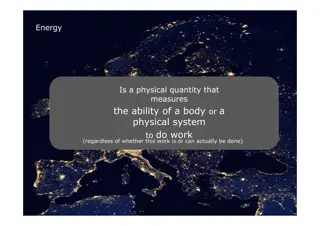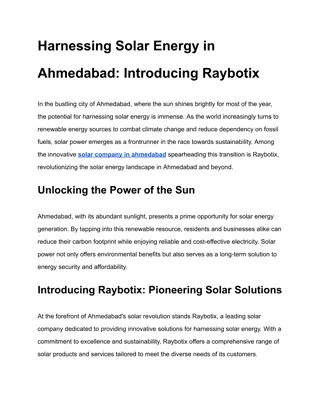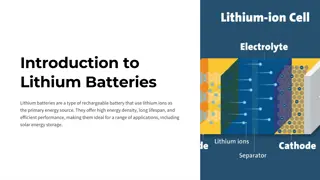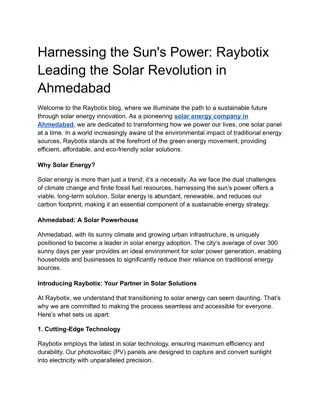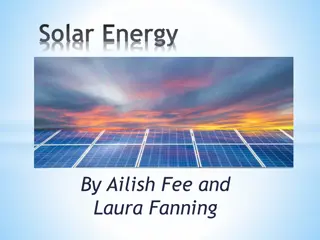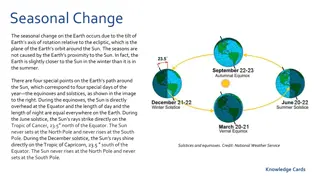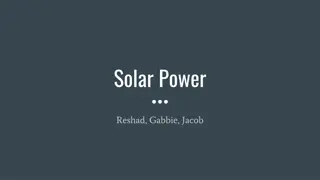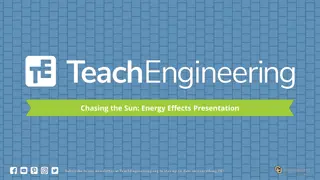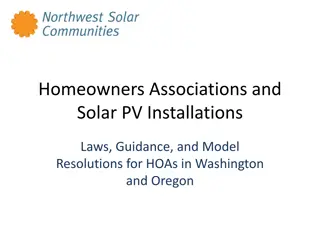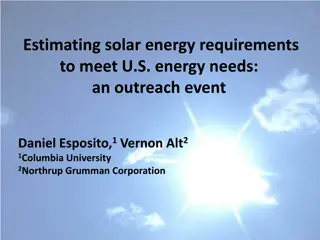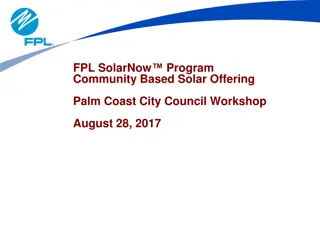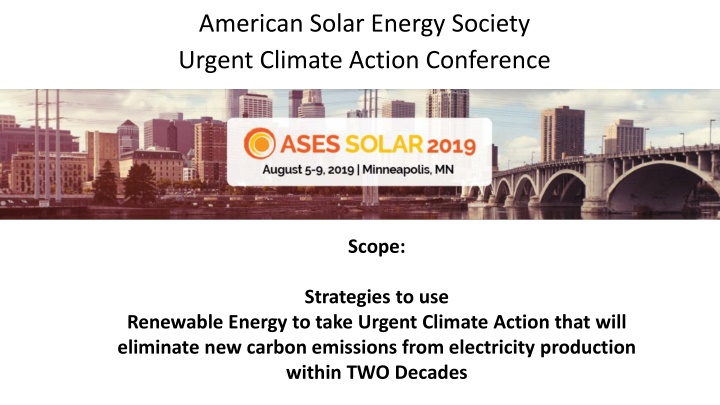
American Solar Energy Society
"Explore effective renewable energy strategies to combat climate change by eliminating carbon emissions from electricity production within two decades. Join the urgent climate action conference organized by the American Solar Energy Society."
Download Presentation

Please find below an Image/Link to download the presentation.
The content on the website is provided AS IS for your information and personal use only. It may not be sold, licensed, or shared on other websites without obtaining consent from the author. If you encounter any issues during the download, it is possible that the publisher has removed the file from their server.
You are allowed to download the files provided on this website for personal or commercial use, subject to the condition that they are used lawfully. All files are the property of their respective owners.
The content on the website is provided AS IS for your information and personal use only. It may not be sold, licensed, or shared on other websites without obtaining consent from the author.
E N D
Presentation Transcript
American Solar Energy Society Urgent Climate Action Conference Scope: Strategies to use Renewable Energy to take Urgent Climate Action that will eliminate new carbon emissions from electricity production within TWO Decades
SOLAR 2019 SESSION HIGHLIGHTS John Dunlop Conference Chair
Climate Action at the International, National, State Climate Action at the International, National, State and City Level; Business Opportunities and City Level; Business Opportunities Climate crisis demands that we are carbon neutral by mid-century to keep warming to 1.5 C We must be HALFWAY toward that goal within ONE decade - 2030 Need for urgent action already evident Extreme weather events Mass migrations of climate refugees Example: Climate disruption in food-producing nations reduced crop production dramatic reduction in exports food shortage in countries dependent on supply protests against government policies political upheaval climate refugees
Urgent Action in America must happen at the state and local level States and cities must commit to 100% clean energy by 2050 Dramatically ramp up use of renewables Renewable electricity already less costly than running an existing fossil fuel plant Must publicize cost-effectiveness of current technologies Policies must reward businesses for taking urgent climate action Policies must reward energy users for using clean energy for electric power, transportation, and heating and cooling Transmission must be upgraded for nation-wide supply of cost- effective renewables Direct Current, High Voltage (800 kV) transmission has TEN times more carrying capacity than conventional long-distance, high voltage AC lines
Energy efficiency and wise use of energy are critical components of the transformation. We all must do all we can as individuals and power communities to do everything we can to address the climate crisis. We want our children to be able to tell their children that their grandparents YOU WHO ARE IN THIS ROOM RIGHT NOW forced dramatic climate action across the entire economy AND IT WORKED!!!
Essential Minerals: Potential Threat to Renewables Essential Minerals: Potential Threat to Renewables Development Development Advanced solar and wind equipment technologies require essential minerals Magnets Electronics Solar cell manufacturing Essential minerals also required to thousands of consumer products, like cell phones Due to extraction costs, most essential minerals currently supplied by China and countries in South America Known supplies of essential minerals in America may lie in sensitive environmental areas Extraction of minerals from deep in the earth entails toxic wastes Toxic wastes threaten the local environment Mineral extraction in America opposed by concerned citizens Adequate supply of essential minerals for renewable electricity generation to address the climate crisis may be at risk
Integration of Variable Energy Resources Integration of Variable Energy Resources Renewable hydrogen and synthetic natural gas may be a cost- effective alternative to curtailing excess renewable generation under high wind and solar scenarios Running wind and solar systems at partial power allows them to ramp up or down to match variable loads Essentially making the systems a dispatchable energy resource Matching variable loads provides value to the grid Dispatchable renewables can be more cost effective than adding electricity storage
Resource Assessment Resource Assessment Solar Power "Perfect Forecasting" techniques are under development by SUNY (State Univ of NY) Utilities and solar operators will be better able to predict solar system production NASA Earth Radiation models are improving their "bestimates" for the surface radiation network. International goal is to keep warming over the entire globe for all time to less than 0.5 C above current temperatures Annual average temperatures in America are rising about 0.25 C per decade Conference Chair Comment: At +0.25 C per decade, we will already be at the long-term goal of +0.5 C by 2040 Even if new carbon emissions are eliminated by 2040, the the Earth would continue to warm due to previous emissions Carbon emissions must be greatly reduced within the next five years to curtail warming to much less than +0.5 C by 2040
Energy Storage Energy Storage Must compare alternative storage economics Storage may provide: Lower peak demand Load shaping services Batteries vs pumped-storage hydro Pumped storage may be possible in a large number of applications Pumped storage in the best locations may be more cost-effective than lithium-ion battery storage From a climate perspective, the long time-frame to implement storage technologies must be considered Education is necessary to help people understand the nuanced value of the cost of storage
Communicating Climate Action Communicating Climate Action -Telling stories can be an effective communication method -Numbers get in the way of effective communication -Talk about why things matter -Experiencing is more impactful than hearing -Balance fear with hope and action -Effective communication starts with knowledge of facts, society, location, and history
Solar Commons Solar Commons Community Trust Ownership would allow solar net metering benefits to be shared with Low and Moderate Income (LMI) communities Understanding the financial nuances of Community Trusts is essential Community Trust needs enhanced technical security while remaining easily usable Effective marketing is important Solar Commons can quickly scaled to 10 gigawatts over the next 15 years Risk: Net metering laws are vulnerable to changing public policy
Value of Solar Homes Value of Solar Homes Solar installed on residential homes reduce operating costs over the life of the project How is the value of the future reduced operating cost reflected in the sale price of a home? The price a buyer is willing to pay for a house reflects the value the place on the home s features including the solar system installed The value added by a solar system will vary based on many demographics, such community, jurisdiction, state or utility The value of a solar system needs to be understood by estate agents, appraisers, inspectors, assessors, home sellers, and home buyers Solar installers need to provide the technical and operational information necessary to convey the home s value at the time of sale Green certification programs provide independent, third-party assessment of the benefits provided by the solar system assisting in the appraisal of the house
Community Solar Community Solar Community solar allows a utility customer to subscribe to a portion of the output of a large solar system not located on their property and receive a credit from their utility Community solar structured properly can address equity disparities Value of Solar community solar credits from utilities can accelerate market-based economic dispatch Compensating the PV owner for all benefits the system provides is not a subsidy The value of solar creates an immediate revenue-neutral relationship between the community solar owner and their utility Community Solar Legislation should include relatively detailed provisions rather than deferring those details to the potentially contentious regulatory process.
Electric Transportation Electric Transportation Electric vehicles fully or partially eliminate carbon emissions transportation Decarbonization of the transportation sector is critical to climate action goals Electric vehicles can provide cost savings on a life cycle cost basis The value of electric vehicles may change between markets, business cases, charging infrastructure available, limited current available to power fast chargers Large scale EV charging (daytime/nighttime charging, workplace charging, home charging, fast charging) may adversely impact utility supply infrastructure and planning Charging from renewable energy sources is essential for decarbonization
Public policies at the city, state, and national level impact the potential for decarbonization of the transportation sector Utility planning Meeting aggregate power demand Public charging infrastructure Technologies and public policies can rapidly change, creating uncertainty Interdependence of charging patterns and utility supplies require coordination Coordination cannot occur without communication Communication requires electronic communication between the EV and the utility, which will require cyber security measures Potential buyers benefit by talking with EV owners ASES members who talked with EV owners at Electric Avenue on Monday engaged in robust discussions
The market value of EVs can be severely impacted by FUD FEAR, UNCERTAINTY AND DOUBT Unwarranted FUD messages can be perpetrated by the conventional vehicle and fossil industries EVs can be linked directly with on-site PV as well as utility-supplied renewable electricity PV can power public chargers at wayside rest areas Battery electric vehicle can include smaller transportation modes Lite Solar Vehicles, small delivery vehicles, scooters, bicycles Electric semis are available on the market today Electric semis have a range over 350 miles Loaded electric semis can reach 60 mph in 30 seconds vs 120 seconds in a diesel semi High capacity fast chargers can charge the semi battery in less than an hour
FINANCING Innovative models can bring financing to the community level Examples include Clean Energy Credit Union Can provide competitive loans with no money down Commercial Investment Tax Credit for businesses due to be reduced from 30% to 26% on January 1 Strategies to capture the full 30% value for installations after January 1 require deep understanding of federal safe harbor rules Professional advice may be advisable Residential systems must be operational by 2019 December 31 to receive the full 30% tax credit
POSTERS Renewable Disaster Recovery Use portable solar generators for emergency power without depending on fuel supplies Also usable as temporary clean, silent power for events Taming the Duck Curve Add controls for solar plus load flexibility for buildings Increase building efficiency Use smart on-site generation (PV plus batteries) to shift to peak utility demand times Buildings can be a flexible resource for a renewable-dominated grid Even historic buildings can be heated with district heating and cooling
Innovative PV materials 3-D printing of PV panels may be possible with Methyl Ammonium Lead Halide Perovskite Solar Cells Standardizing EV charging and/or switching stations may reduce cost and complexity International examples of innovative technologies Can stimulate new strategies for reducing carbon emissions Posters will be available for review at www.ASES.org
WRAP UP WRAP UP RAPID DEPLOYMENT OF RENEWABLE ENERGY WILL ATTACK THE CLIMATE CRISIS!!! WE CAN WIN THE RACE AGAINST TIME





